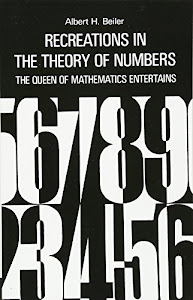
Recreations in the Theory of Numbers
Catégorie: Entreprise et Bourse, Santé, Forme et Diététique, Livres pour enfants
Auteur: Stéphanie Bioret
Éditeur: Nikki Sixx, Michael Newton
Publié: 2019-10-18
Écrivain: Tayari Jones
Langue: Tchèque, Grec ancien, Grec, Polonais
Format: pdf, Livre audio
Auteur: Stéphanie Bioret
Éditeur: Nikki Sixx, Michael Newton
Publié: 2019-10-18
Écrivain: Tayari Jones
Langue: Tchèque, Grec ancien, Grec, Polonais
Format: pdf, Livre audio
Prime number - Wikipedia - Prime numbers are also used in pseudorandom number generators including linear congruential generators and the Mersenne Twister. Other applications. Prime numbers are of central importance to number theory but also have many applications to other areas within mathematics, including abstract algebra and elementary
graph theory | Problems & Applications | Britannica - Mathematical recreations comprise puzzles and games that vary from naive amusements to sophisticated problems, some of which have never been solved. They may involve arithmetic, algebra, geometry, theory of numbers, graph theory, topology, matrices, group theory, combinatorics (dealing… combinatorics: Combinatorics during the 20th century …of interest in combinatorics is graph theory, the ...
Parks and Recreation — Wikipédia - Parks and Recreation (également connu sous le nom de Parks and Rec ou Parcs et Loisirs en français) est une sitcom américaine créée par Greg Daniels et Michael Schur diffusée sur le réseau NBC entre le 9 avril 2009 et le 24 février s'étend sur sept saisons et 125 épisodes d'une durée allant d'environ 22 minutes à plus de 40 minutes pour certains épisodes.
レピュニット - Wikipedia - レピュニット (レピュニット数、レプユニット数、単位反復数、英: Repunit) とは 1, 11, 111, 1111, …のように全ての桁の数字が 1である自然数のことである。 名前の由来は repeated unitを省略した単語であり、1966年にアルバート・ベイラーが Recreations in the Theory of Numbers の中で命名したものである 。
Prime Notation (Lagrange), Function & Numbers - Calculus ... - Prime numbers aren’t generally used in statistics (other than those number appearing in data), but statistics and probabilities are used to work with prime numbers in number theory. For example, you might want to find the probability of choosing a prime number from a series of numbers. The odds depend on what interval you choose:
Wolfram Demonstrations Project - Explore thousands of free applications across science, mathematics, engineering, technology, business, art, finance, social sciences, and more.
Prime Number -- from Wolfram MathWorld - Prime Number. A prime number (or prime integer, often simply called a "prime" for short) is a positive integer that has no positive integer divisors other than 1 and itself. More concisely, a prime number is a positive integer having exactly one positive divisor other than 1, meaning it is a number that cannot be factored. For example, the only divisors of 13 are 1 and 13, making 13 a prime ...
Recreational mathematics - Wikipedia - Recreational mathematics is mathematics carried out for recreation (entertainment) rather than as a strictly research and application-based professional activity or as a part of a student's formal education. Although it is not necessarily limited to being an endeavor for amateurs, many topics in this field require no knowledge of advanced mathematics.
Schnapszahl – Wikipedia - Eine Schnapszahl (anhören? / i) ist eine mehrstellige natürliche Zahl, die ausschließlich durch identische Ziffern dargestellt wird. In der Mathematik werden diese Zahlen auch als Repdigit, englisch für repeated digits, deutsch wiederholte Ziffern, bezeichnet.. Diese Seite wurde zuletzt am 14. April 2021 um 09:39 Uhr bearbeitet.
Goldbach Conjecture -- from Wolfram MathWorld - Goldbach's original conjecture (sometimes called the "ternary" Goldbach conjecture), written in a June 7, 1742 letter to Euler, states "at least it seems that every number that is greater than 2 is the sum of three primes" (Goldbach 1742; Dickson 2005, p. 421). Note that Goldbach considered the number 1 to be a prime, a convention that is no longer followed.
[english], [pdf], [audible], [audiobook], [online], [goodreads], [download], [epub], [free], [read], [kindle]


















0 komentar:
Posting Komentar
Catatan: Hanya anggota dari blog ini yang dapat mengirim komentar.